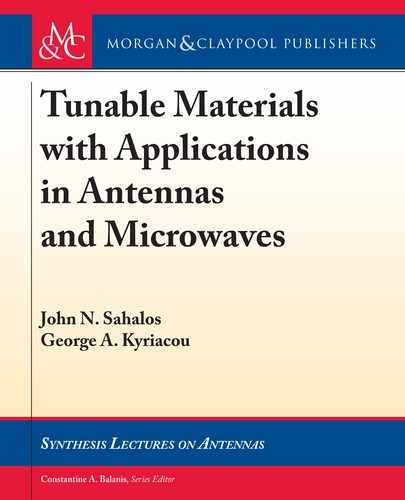
2.20. HYSTERESIS LOOP OF FERROELECTRICS 59
Resistor
50 Ω Transmission
Line
Capacitor
Tunable Antenna
Partly Transparent Sealing
Ferroelectric Layer
for Electrical Tuning
Microwave Filter
Piezoelectric Layer
ermal Vias and
Ground
Dielectric Layers for
Low-Loss Components
Ferrimagnetic Layer for
Radiation Protection or
Electrical Shortening
Coupler
GRD
SIG
POW
POW
PCB
SIG
SIG
SIG
GRD
GRD
DIE
MEMS
Figure 2.29: Cross-section of a typical tunable microwave circuit exploiting ferroelectric material
features (LTCC modules) [40, 59, 60].
common interface must have the following [40]: (i) similar crystal symmetry, (ii) similar plane
lattice parameters, (iii) similar thermal expansion coefficients, and (iv) chemical stability. In
order to meet these requirements, the selection of the appropriate substrate, electrode, and di-
electric materials is essential. e employment of the appropriate film growth technology and
its specific parameters is also essential.
2.20 HYSTERESIS LOOP OF FERROELECTRICS
Ferroelectrics like BSTO exhibit spontaneous polarization due to a permanent dipole orien-
tational mechanism. e dipoles are strongly coupled and form domains in a way similar to
ferrites. Below the Curie temperature, they present a hysteresis loop associated with high mi-
crowave losses. Its dielectric constant can be tuned by varying the applied electric field in both its
ferroelectric and paraelectric states (below and above the Curie temperature, respectively). e
latter is very important since microwave losses are quite lower in the paraelectric state due to the
..................Content has been hidden....................
You can't read the all page of ebook, please click here login for view all page.
